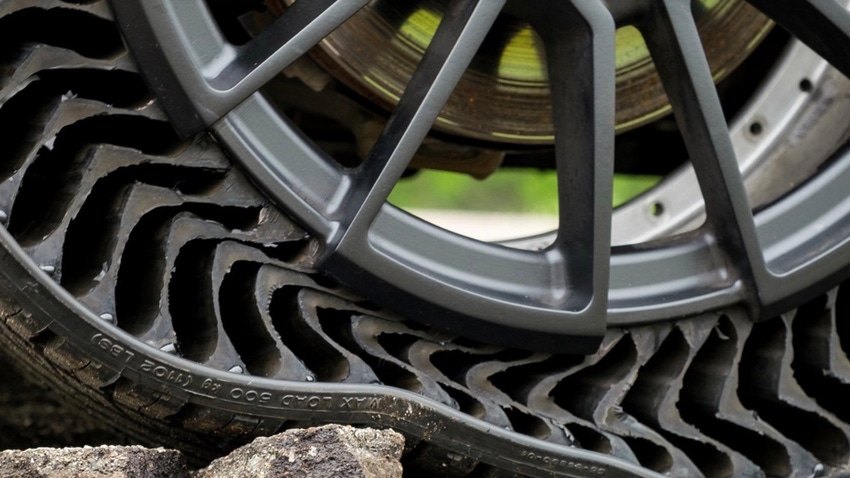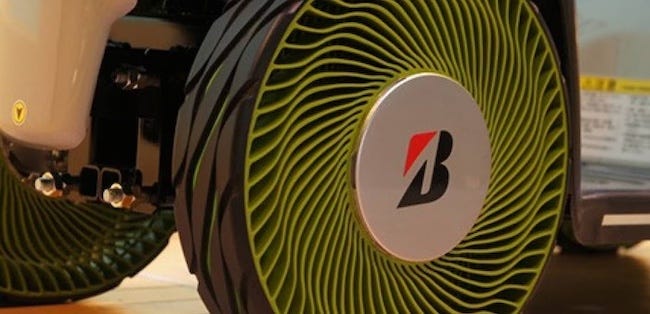Taking the Air Out of Tires Isn’t a Bad Thing
Michelin continues to lead efforts to introduce airless, puncture-proof traction, with other tiremakers in the fray.
December 8, 2023

At a Glance
- Benefits of airless, puncture-proof tires include reduced waste and optimized fuel economy
- Fewer raw materials and less energy required for tire production
- Technology has potential in commercial vehicle and military applications
As automakers seek enhanced sustainability, while taking the pain out of changing tires for drivers, the benefits of airless, puncture-less tread are becoming increasingly obvious. Currently being put through their paces on around 50 DHL delivery vans in Singapore, it is apparent that Michelin’s Uptis (Unique Puncture-proof Tire System) tires bring more benefits than just zero punctures.
Insufficient tire pressure not only causes fuel economy to decline. It is also a cause of irregular tire wear, leading to around 8% of tires in use being prematurely scrapped. Tag onto that the 12% of tires scrapped each year due to “unrepairable air loss failures” and that’s an estimated 200 million tires down the tubes annually. Uptis could remedy that.
Production of Michelin’s Uptis tires consumes less energy
In addition, the production process for Uptis is less energy-intensive than for standard tires, while fewer raw materials are required, albeit with more plastics finding its way into the system. Michelin initially intended to launch Uptis commercially in 2024, so here’s hoping we’ll see them on a street near you sooner rather than later. It will represent a major step change given the detachable pneumatic tire we know so well was introduced by its inventors André and Édouard Michelin way back in 1895.
Benefits for farming and construction
Bridgestone has also been developing airless tire technology for more than a decade. The development phase has been extended on account of several major design challenges, including finding a way to avoid trapping debris within the spokes, as well as developing the best way to distribute weight evenly and consistently transmit loads. For reasons like these, Bridgestone said that “[as of early 2022] many spectators think airless tires are still a decade or so away.”

Finding a way to avoid trapping debris within the spokes of airless tires is a key development challenge, according to Bridgestone. Image courtesy of Bridgestone.
Besides no flat tires — ever — Bridgestone cites additional advantages of airless tires. Some are obvious, like no longer needing a spare tire, which will free up more trunk space. The tire maker also says airless tires could be a major boost for special vehicles used in the farming, mining, and construction industries. Downtime in these sectors can lead to loss of productivity and efficiency.
Bridgestone also highlights that about 90% of energy loss from tire rolling resistance comes from repeated changes in the shape of the tires as they roll. By simplifying the structure of the air-free concept tires, Bridgestone has been able to minimize this energy loss.
Military deployment
Korea’s Hankook has developed its own version of the airless tire with polymer spokes supporting a rubber tread. Its non-pneumatic tire (NPT), dubbed i-Flex, was recently fitted to a Hyundai Rotem multi-purpose unmanned ground vehicle designed to support military operations. The i-Flex airless tire delivers quick traction and rotational function to autonomous vehicles in off-road terrain environments.

The i-Flex airless tire has been specifically designed for autonomous military vehicle use. Image courtesy of Hankook.
A dual-arch structure is adopted in the i-Flex to support heavy loads and evenly distribute the vehicle’s weight. The outer arch primarily absorbs irregular shocks transmitted from the off-road surface, while the inner arch alleviates further shocks that are transmitted to the vehicle’s actuators. In addition, technology to allow for 360-degree in-place tire rotation has been applied to the tread pattern of the i-Flex. Hankook spent 12 years developing the i-Flex.
About the Author(s)
You May Also Like




